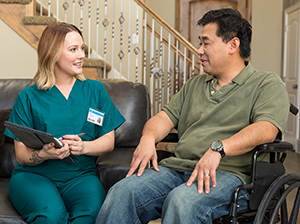Spinal Cord Injury (SCI): Emergency Preparedness
Spinal Cord Injury (SCI): Emergency Preparedness
In an emergency, such as a natural disaster, people with SCI may have additional needs to consider. Make a plan for your own safety. Preparing in advance can help you better cope with an emergency. Planning can help lessen the impact it has on your life.
Know your risks and assess your needs
Start by learning about the kinds of emergencies that might affect you. This can include things specific to where you live, such as floods, earthquakes, tornados, and snowstorms. Fires and power outages could happen at any time. Think about how each type of emergency could affect your normal routine. Then make a list of your needs. Some questions to consider include:
Do you live alone or with others?
Does someone help you with your daily routine and activities? Will this person likely be with you in an emergency?
Do you use equipment, such as a wheelchair, for mobility? Will you still have access to this equipment in an emergency?
Do you have medical supplies that you use daily?
Are there medicines or other treatments that you need daily?
For each question, you need to come up with an answer and have an option for what you’ll do instead in an emergency.
Make a plan for your safety
If you know that you’ll likely need help in an emergency, create a support network of people to assist you in advance. Include family members, friends, neighbors, and co-workers in your network. Discuss with them ahead of time the kind of help you’ll need.
Keep a list of emergency contact numbers in your wallet or near your phone. Know how to contact members of your support network or meet up with them in an emergency.
Contact your local emergency services department. Find out if they keep a list of people who have disabilities or special needs. Add yourself to this list. Emergency relief workers will know that you may need additional help.
Contact your electricity company. They may have a priority list for people who need power restored quickly in an emergency.
Know the location of the nearest emergency shelters. Find out in advance if they are accessible with a wheelchair.
Know the safest places to be in your home or workplace during fire, earthquake, flooding, or tornadoes.
Plan at least 2 escape routes from your home and workplace in case you’re forced to evacuate. If you live or work in a building with more than 1 floor, make sure others know how to move you safely.
Build an emergency kit
In any emergency, you need to be prepared to take care of your own needs for at least 3 days or longer. This is in case help does not reach you right away. One way to prepare is to build an emergency supply kit. This kit should contain basic items to help you survive, such as food and water. It should also contain supplies and equipment that you need with you to help maintain your health and mobility. Also pack a small bag that contains your most needed items. Be ready to grab this bag on short notice if you have to leave your location quickly. Here are some extra things you may need in your kit:
Medical supplies, such as incontinence pads and catheters for bowel and bladder care
Assistive devices, such as glasses, hearing aids, canes, and walkers
Backup chargers and batteries for powered wheelchairs
A backup manual wheelchair
Extra oxygen and portable ventilator if you need help with breathing
Medicines and a copy of your prescriptions
Medical alert card with information about your medical needs
Emergency contact information for family members and friends
Copies of important documents
Resources to help you
To learn more about how to prepare for an emergency, visit these websites:
American Red Cross www.redcross.org
Centers for Disease Control and Prevention, Emergency Preparedness and Response www.emergency.cdc.gov
Federal Emergency Management Agency www.fema.gov
Ready Campaign www.ready.gov
Updated:
February 27, 2018
Reviewed By:
Fetterman, Anne, RN, BSN,Images Reviewed by Staywell medical art team.,Jasmin, Luc, MD
